TOYOTA HILUX 2018 Owners Manual
Manufacturer: TOYOTA, Model Year: 2018, Model line: HILUX, Model: TOYOTA HILUX 2018Pages: 708, PDF Size: 95.31 MB
Page 641 of 708
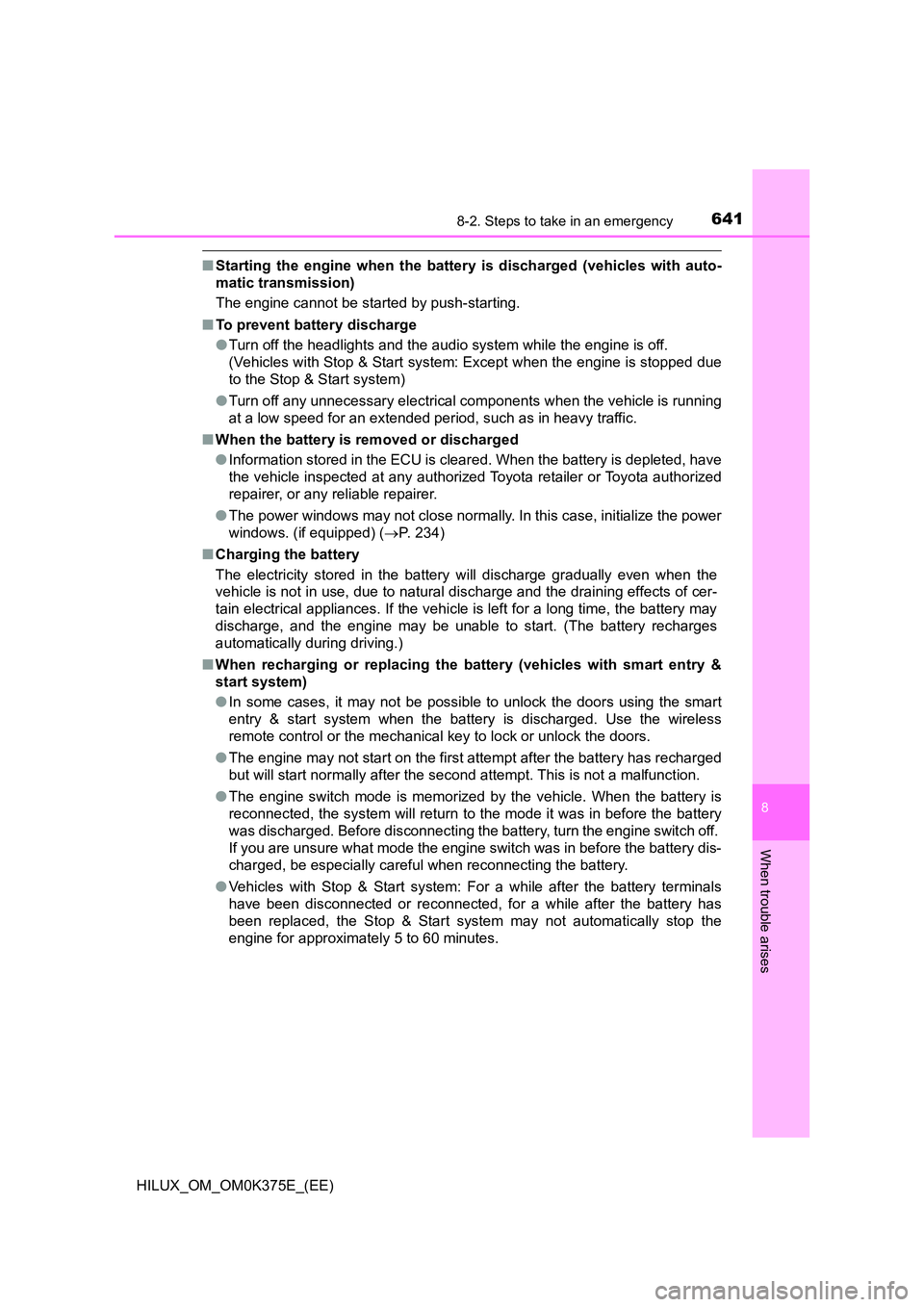
6418-2. Steps to take in an emergency
HILUX_OM_OM0K375E_(EE)
8
When trouble arises
■Starting the engine when the battery is discharged (vehicles with auto-
matic transmission)
The engine cannot be started by push-starting.
■ To prevent battery discharge
● Turn off the headlights and the audio system while the engine is off.
(Vehicles with Stop & Start system: Except when the engine is stopped due
to the Stop & Start system)
● Turn off any unnecessary electrical components when the vehicle is running
at a low speed for an extended period, such as in heavy traffic.
■ When the battery is removed or discharged
● Information stored in the ECU is cleared. When the battery is depleted, have
the vehicle inspected at any authorized Toyota retailer or Toyota authorized
repairer, or any reliable repairer.
● The power windows may not close normally. In this case, initialize the power
windows. (if equipped) ( P. 234)
■ Charging the battery
The electricity stored in the battery will discharge gradually even when the
vehicle is not in use, due to natural discharge and the draining effects of cer-
tain electrical appliances. If the vehicle is left for a long time, the battery may
discharge, and the engine may be unable to start. (The battery recharges
automatically during driving.)
■ When recharging or replacing the battery (vehicles with smart entry &
start system)
● In some cases, it may not be possible to unlock the doors using the smart
entry & start system when the battery is discharged. Use the wireless
remote control or the mechanical key to lock or unlock the doors.
● The engine may not start on the first attempt after the battery has recharged
but will start normally after the second attempt. This is not a malfunction.
● The engine switch mode is memorized by the vehicle. When the battery is
reconnected, the system will return to the mode it was in before the battery
was discharged. Before disconnecting the battery, turn the engine switch off.
If you are unsure what mode the engine switch was in before the battery dis-
charged, be especially careful when reconnecting the battery.
● Vehicles with Stop & Start system: For a while after the battery terminals
have been disconnected or reconnected, for a while after the battery has
been replaced, the Stop & Start system may not automatically stop the
engine for approximately 5 to 60 minutes.
Page 642 of 708
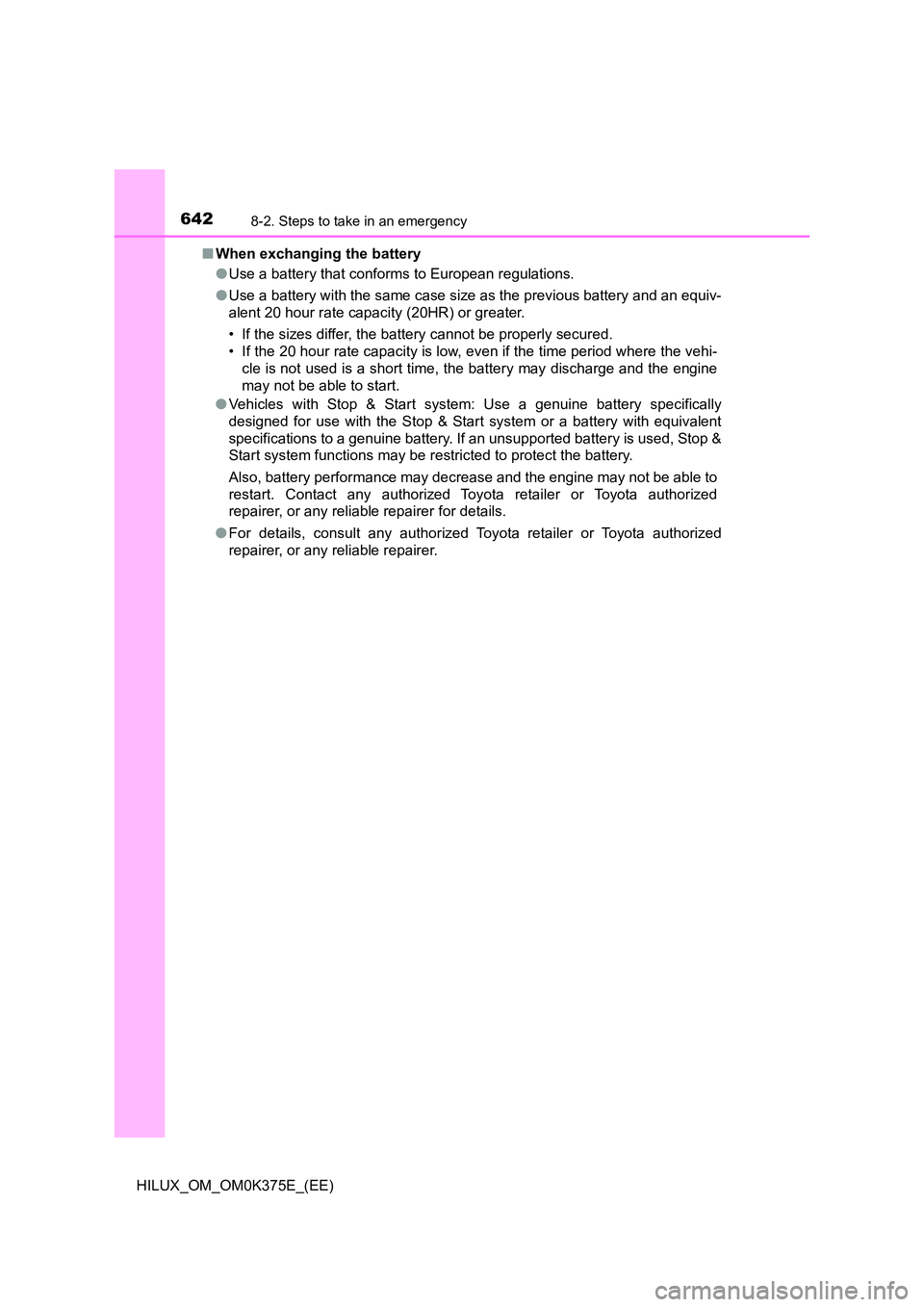
6428-2. Steps to take in an emergency
HILUX_OM_OM0K375E_(EE)
■ When exchanging the battery
● Use a battery that conforms to European regulations.
● Use a battery with the same case size as the previous battery and an equiv-
alent 20 hour rate capacity (20HR) or greater.
• If the sizes differ, the battery cannot be properly secured.
• If the 20 hour rate capacity is low, even if the time period where the vehi-
cle is not used is a short time, the battery may discharge and the engine
may not be able to start.
● Vehicles with Stop & Start system: Use a genuine battery specifically
designed for use with the Stop & Start system or a battery with equivalent
specifications to a genuine battery. If an unsupported battery is used, Stop &
Start system functions may be restricted to protect the battery.
Also, battery performance may decrease and the engine may not be able to
restart. Contact any authorized Toyota retailer or Toyota authorized
repairer, or any reliable repairer for details.
● For details, consult any authorized Toyota retailer or Toyota authorized
repairer, or any reliable repairer.
Page 643 of 708
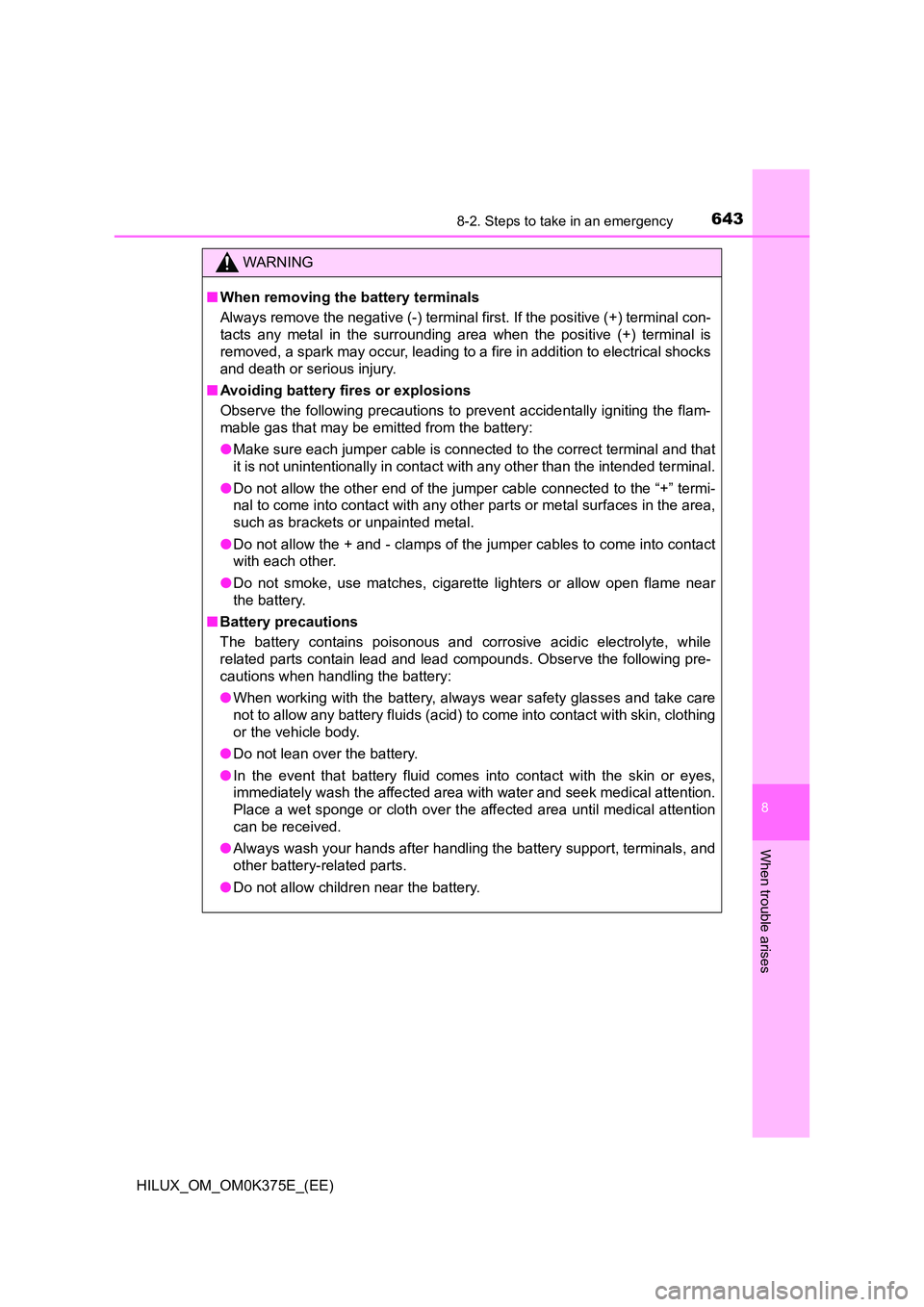
6438-2. Steps to take in an emergency
HILUX_OM_OM0K375E_(EE)
8
When trouble arises
WARNING
■When removing the battery terminals
Always remove the negative (-) terminal first. If the positive (+) terminal con-
tacts any metal in the surrounding area when the positive (+) terminal is
removed, a spark may occur, leading to a fire in addition to electrical shocks
and death or serious injury.
■ Avoiding battery fires or explosions
Observe the following precautions to prevent accidentally igniting the flam-
mable gas that may be emitted from the battery:
● Make sure each jumper cable is connected to the correct terminal and that
it is not unintentionally in contact with any other than the intended terminal.
● Do not allow the other end of the jumper cable connected to the “+” termi-
nal to come into contact with any other parts or metal surfaces in the area,
such as brackets or unpainted metal.
● Do not allow the + and - clamps of the jumper cables to come into contact
with each other.
● Do not smoke, use matches, cigarette lighters or allow open flame near
the battery.
■ Battery precautions
The battery contains poisonous and corrosive acidic electrolyte, while
related parts contain lead and lead compounds. Observe the following pre-
cautions when handling the battery:
● When working with the battery, always wear safety glasses and take care
not to allow any battery fluids (acid) to come into contact with skin, clothing
or the vehicle body.
● Do not lean over the battery.
● In the event that battery fluid comes into contact with the skin or eyes,
immediately wash the affected area with water and seek medical attention.
Place a wet sponge or cloth over the affected area until medical attention
can be received.
● Always wash your hands after handling the battery support, terminals, and
other battery-related parts.
● Do not allow children near the battery.
Page 644 of 708
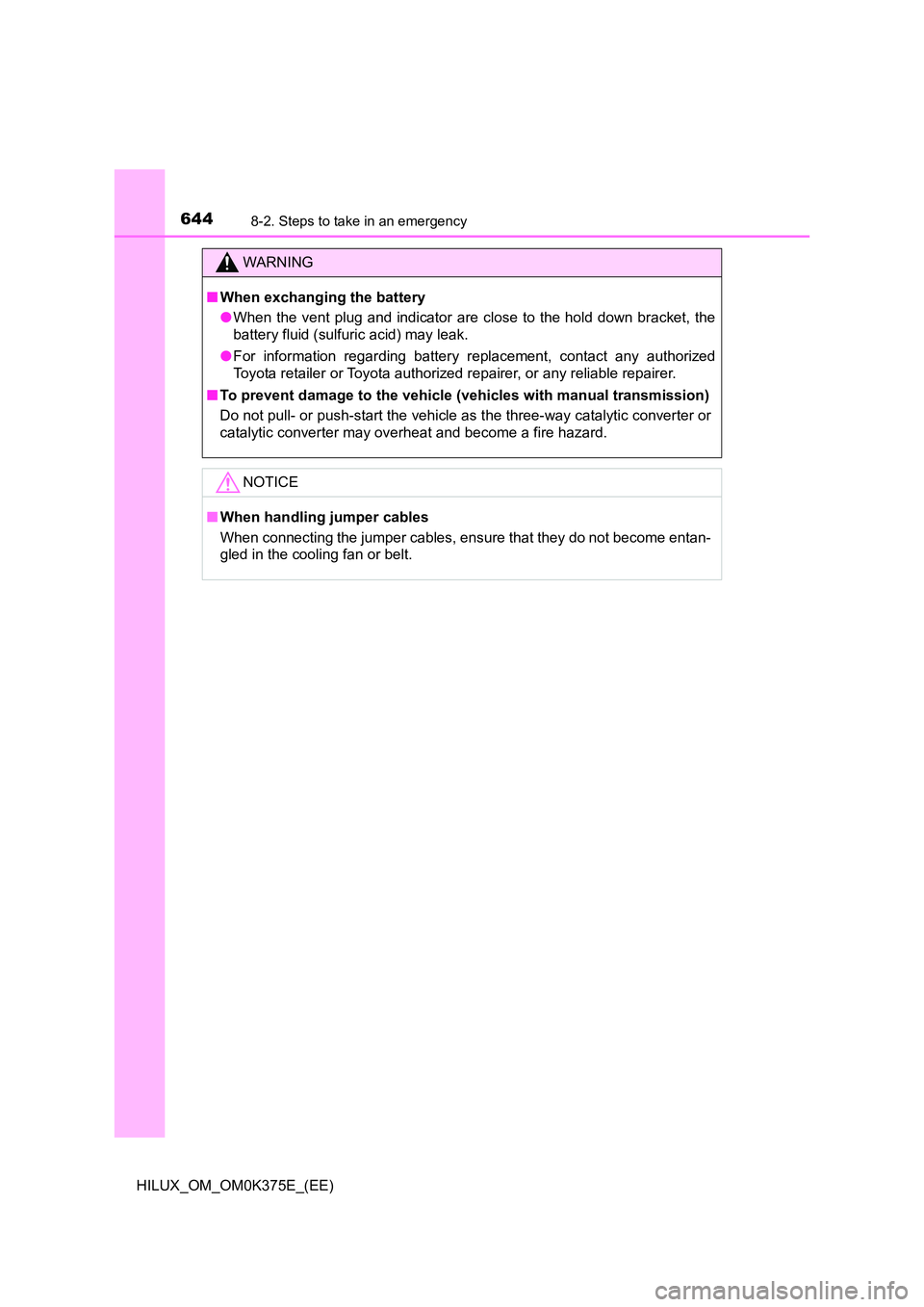
6448-2. Steps to take in an emergency
HILUX_OM_OM0K375E_(EE)
WARNING
■When exchanging the battery
● When the vent plug and indicator are close to the hold down bracket, the
battery fluid (sulfuric acid) may leak.
● For information regarding battery replacement, contact any authorized
Toyota retailer or Toyota authorized repairer, or any reliable repairer.
■ To prevent damage to the vehicle (vehicles with manual transmission)
Do not pull- or push-start the vehicle as the three-way catalytic converter or
catalytic converter may overheat and become a fire hazard.
NOTICE
■ When handling jumper cables
When connecting the jumper cables, ensure that they do not become entan-
gled in the cooling fan or belt.
Page 645 of 708
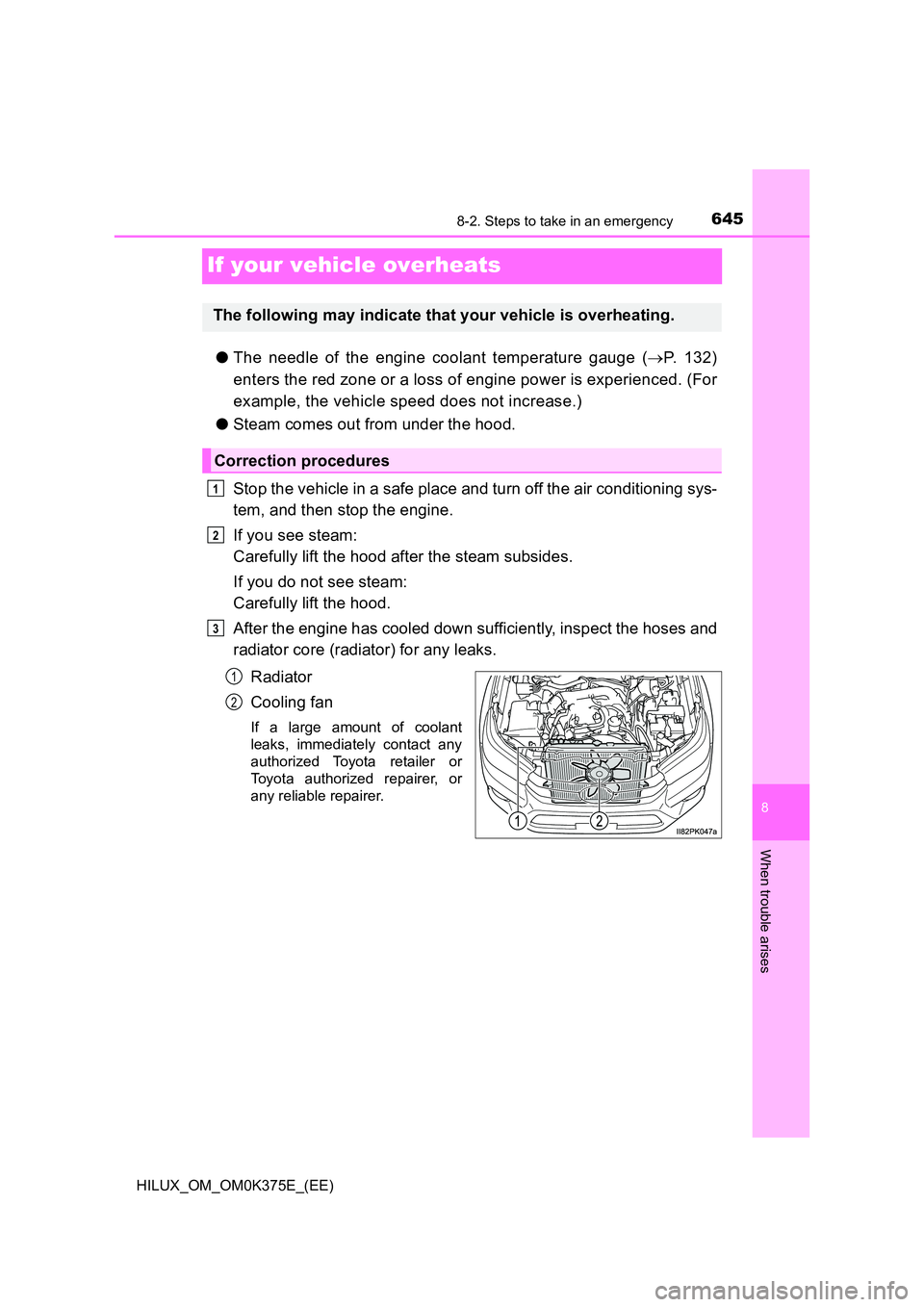
6458-2. Steps to take in an emergency
HILUX_OM_OM0K375E_(EE)
8
When trouble arises
If your vehicle overheats
●The needle of the engine coolant temperature gauge (P. 132)
enters the red zone or a loss of engine power is experienced. (For
example, the vehicle speed does not increase.)
● Steam comes out from under the hood.
Stop the vehicle in a safe place and turn off the air conditioning sys-
tem, and then stop the engine.
If you see steam:
Carefully lift the hood after the steam subsides.
If you do not see steam:
Carefully lift the hood.
After the engine has cooled down sufficiently, inspect the hoses and
radiator core (radiator) for any leaks.
Radiator
Cooling fan
If a large amount of coolant
leaks, immediately contact any
authorized Toyota retailer or
Toyota authorized repairer, or
any reliable repairer.
The following may indicate that your vehicle is overheating.
Correction procedures
1
2
3
1
2
Page 646 of 708
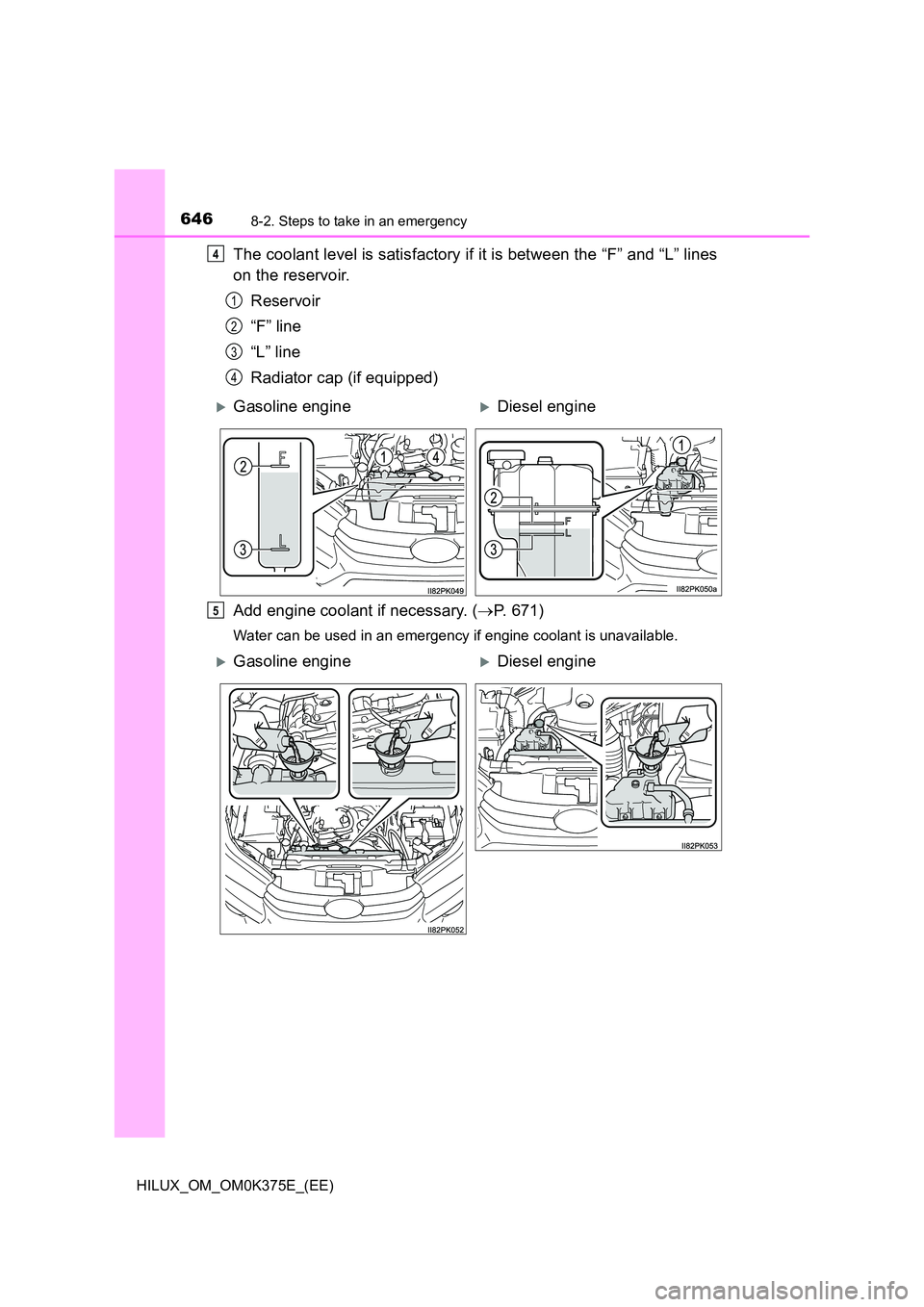
6468-2. Steps to take in an emergency
HILUX_OM_OM0K375E_(EE)
The coolant level is satisfactory if it is between the “F” and “L” lines
on the reservoir.
Reservoir
“F” line
“L” line
Radiator cap (if equipped)
Add engine coolant if necessary. ( P. 671)
Water can be used in an emergency if engine coolant is unavailable.
4
1
2
3
4
Gasoline engineDiesel engine
5
Gasoline engineDiesel engine
Page 647 of 708
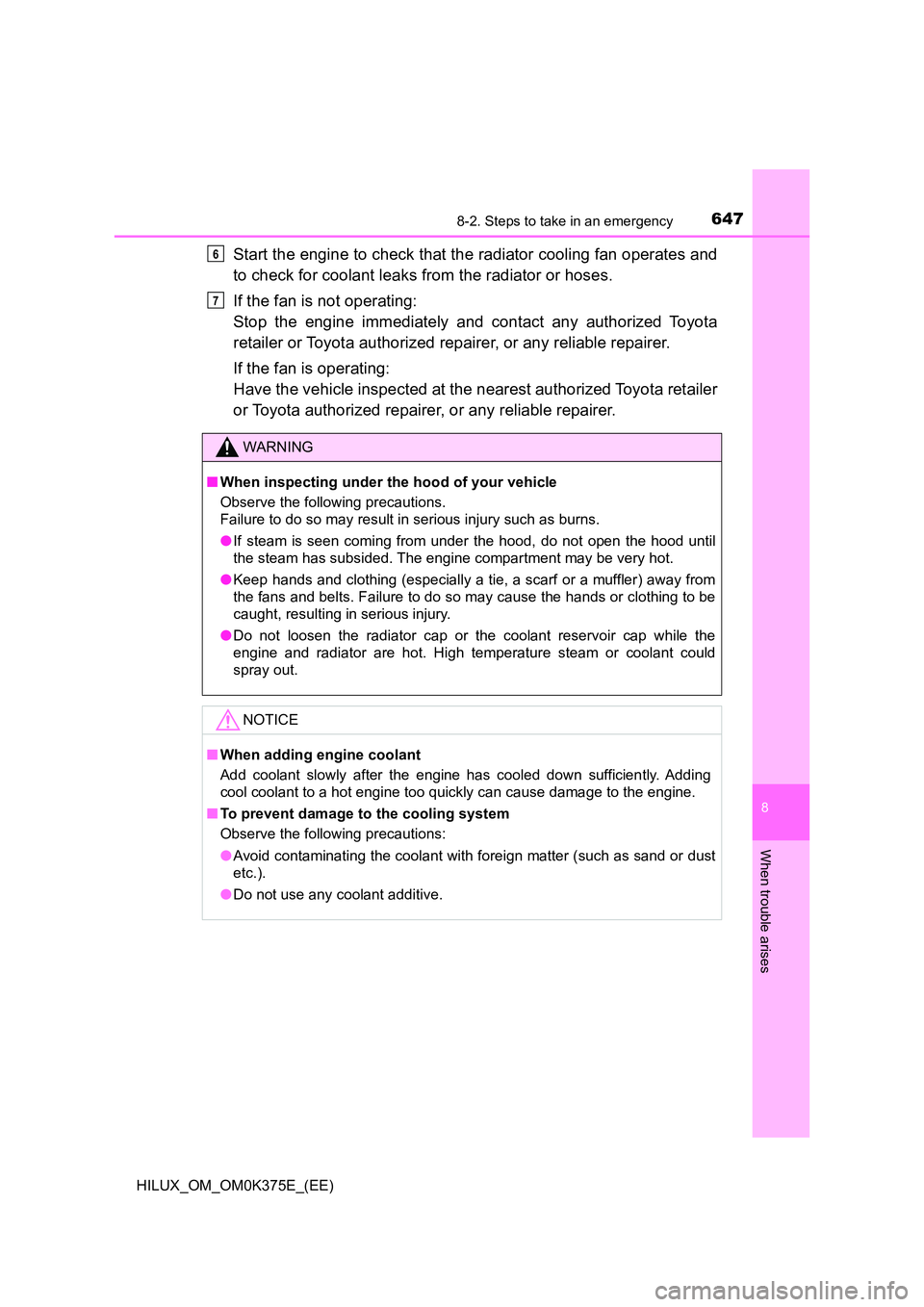
6478-2. Steps to take in an emergency
HILUX_OM_OM0K375E_(EE)
8
When trouble arises
Start the engine to check that the radiator cooling fan operates and
to check for coolant leaks from the radiator or hoses.
If the fan is not operating:
Stop the engine immediately and contact any authorized Toyota
retailer or Toyota authorized repairer, or any reliable repairer.
If the fan is operating:
Have the vehicle inspected at the nearest authorized Toyota retailer
or Toyota authorized repairer, or any reliable repairer.
WARNING
■ When inspecting under the hood of your vehicle
Observe the following precautions.
Failure to do so may result in serious injury such as burns.
● If steam is seen coming from under the hood, do not open the hood until
the steam has subsided. The engine compartment may be very hot.
● Keep hands and clothing (especially a tie, a scarf or a muffler) away from
the fans and belts. Failure to do so may cause the hands or clothing to be
caught, resulting in serious injury.
● Do not loosen the radiator cap or the coolant reservoir cap while the
engine and radiator are hot. High tem perature steam or coolant could
spray out.
NOTICE
■ When adding engine coolant
Add coolant slowly after the engine has cooled down sufficiently. Adding
cool coolant to a hot engine too quickly can cause damage to the engine.
■ To prevent damage to the cooling system
Observe the following precautions:
● Avoid contaminating the coolant with foreign matter (such as sand or dust
etc.).
● Do not use any coolant additive.
6
7
Page 648 of 708
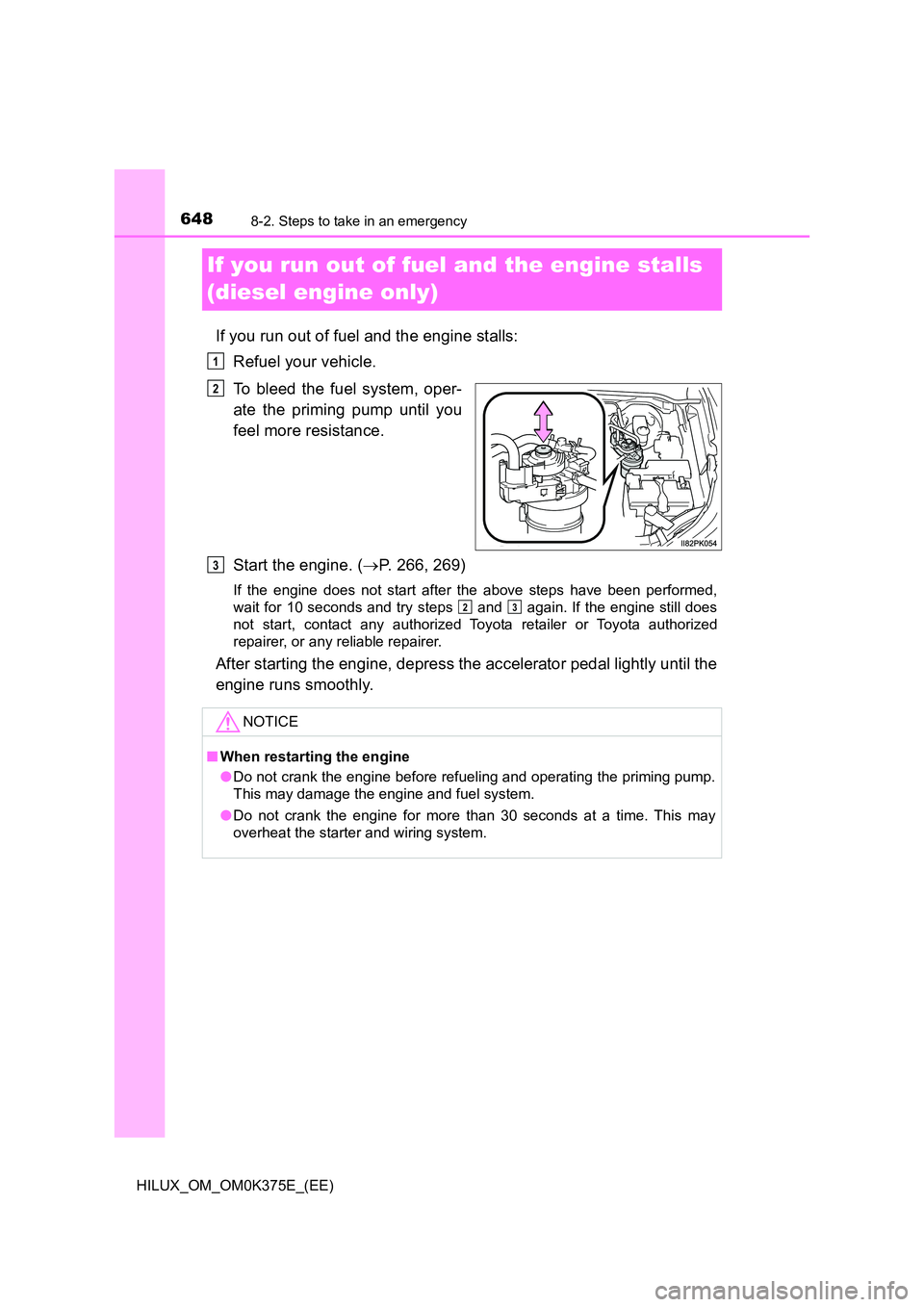
6488-2. Steps to take in an emergency
HILUX_OM_OM0K375E_(EE)
If you run out of fuel and the engine stalls
(diesel engine only)
If you run out of fuel and the engine stalls:
Refuel your vehicle.
To bleed the fuel system, oper-
ate the priming pump until you
feel more resistance.
Start the engine. ( P. 266, 269)
If the engine does not start after the above steps have been performed,
wait for 10 seconds and try steps and again. If the engine still does
not start, contact any authorized Toyo ta retailer or Toyota authorized
repairer, or any reliable repairer.
After starting the engine, depress the accelerator pedal lightly until the
engine runs smoothly.
1
2
NOTICE
■ When restarting the engine
● Do not crank the engine before refueling and operating the priming pump.
This may damage the engine and fuel system.
● Do not crank the engine for more than 30 seconds at a time. This may
overheat the starter and wiring system.
3
23
Page 649 of 708
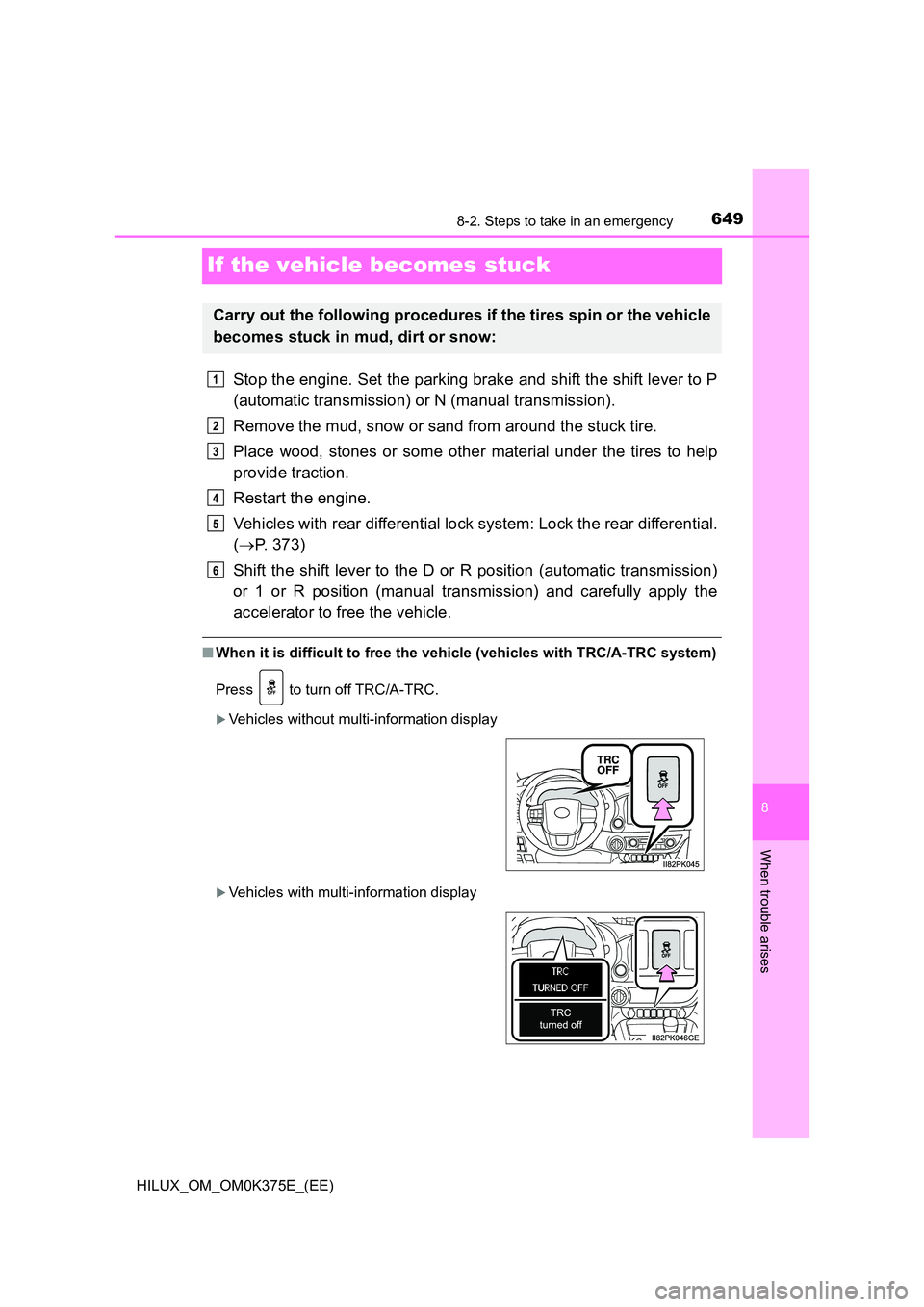
6498-2. Steps to take in an emergency
HILUX_OM_OM0K375E_(EE)
8
When trouble arises
If the vehicle becomes stuck
Stop the engine. Set the parking brake and shift the shift lever to P
(automatic transmission) or N (manual transmission).
Remove the mud, snow or sand from around the stuck tire.
Place wood, stones or some other material under the tires to help
provide traction.
Restart the engine.
Vehicles with rear differential lock system: Lock the rear differential.
( P. 373)
Shift the shift lever to the D or R position (automatic transmission)
or 1 or R position (manual transmission) and carefully apply the
accelerator to free the vehicle.
■ When it is difficult to free the vehicle (vehicles with TRC/A-TRC system)
Press to turn off TRC/A-TRC.
Vehicles without multi-information display
Vehicles with multi-information display
Carry out the following procedures if the tires spin or the vehicle
becomes stuck in mud, dirt or snow:
1
2
3
4
5
6
Page 650 of 708
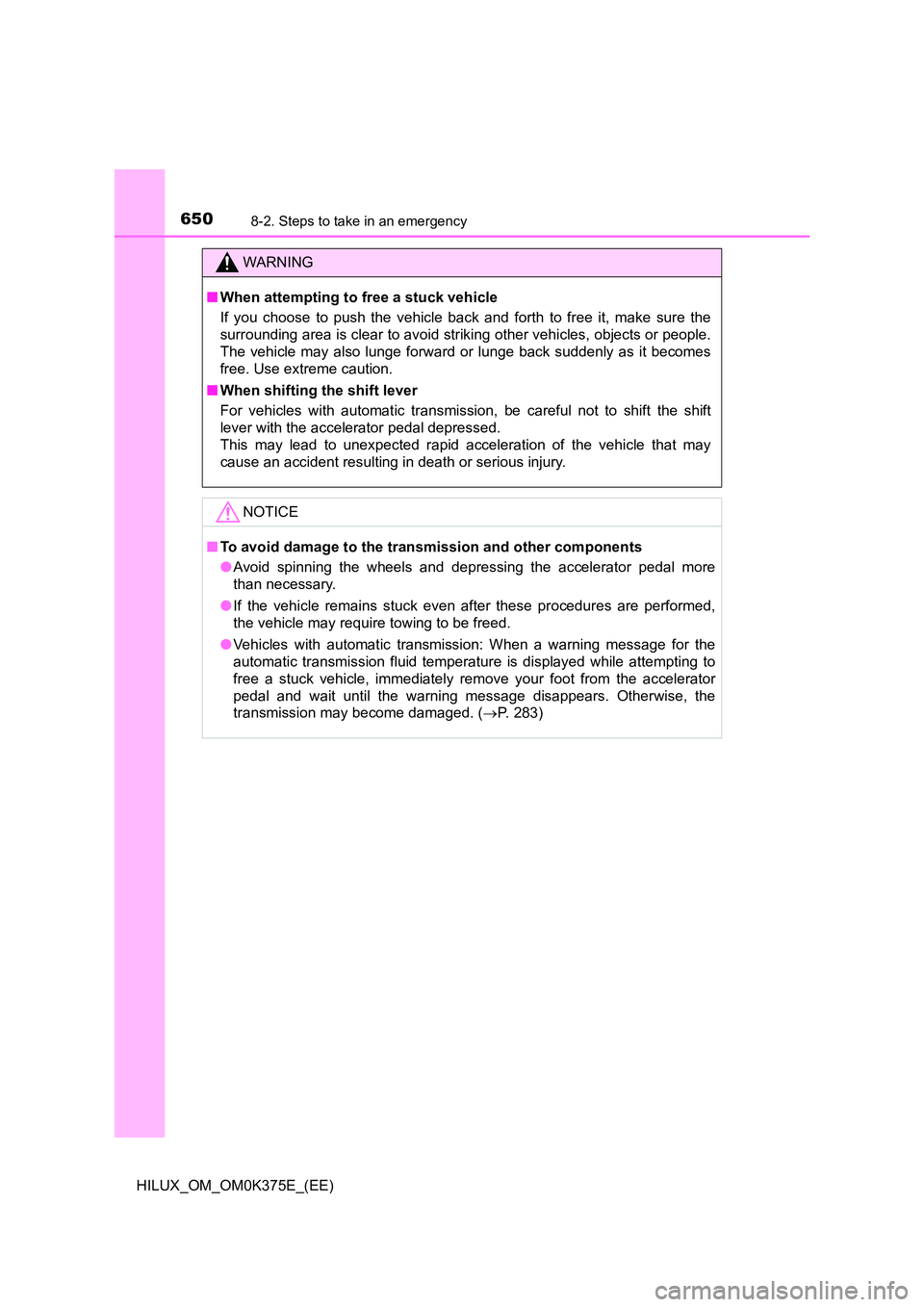
6508-2. Steps to take in an emergency
HILUX_OM_OM0K375E_(EE)
WARNING
■When attempting to free a stuck vehicle
If you choose to push the vehicle back and forth to free it, make sure the
surrounding area is clear to avoid striking other vehicles, objects or people.
The vehicle may also lunge forward or lunge back suddenly as it becomes
free. Use extreme caution.
■ When shifting the shift lever
For vehicles with automatic transmission, be careful not to shift the shift
lever with the accelerator pedal depressed.
This may lead to unexpected rapid acceleration of the vehicle that may
cause an accident resulting in death or serious injury.
NOTICE
■ To avoid damage to the transmission and other components
● Avoid spinning the wheels and depressing the accelerator pedal more
than necessary.
● If the vehicle remains stuck even after these procedures are performed,
the vehicle may require towing to be freed.
● Vehicles with automatic transmission: When a warning message for the
automatic transmission fluid temperature is displayed while attempting to
free a stuck vehicle, immediately remove your foot from the accelerator
pedal and wait until the warning message disappears. Otherwise, the
transmission may become damaged. ( P. 283)